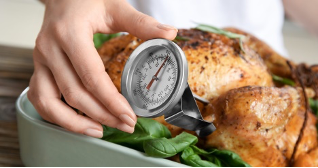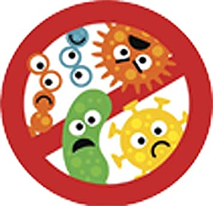FOOD SAFETY TIPS FOR COOKING POULTRY
In an attempt to eat healthier, many have switched to eating more poultry and seafood and less red meat. Nothing against red meat, I love a good thick charbroiled steak, especially on special occasions when one might go out for dinner. But at home, many tend to cook more poultry. We just finished the holidays and turkeys were on many tables. In the summer there is plenty of chicken legs, thighs and quarters for everyone. Covid-19 brings special attention to food safety issues. So it is important to prepare, serve and store your food in accordance with the recommendations of the CDC.
Anytime is a great time to enjoy family meals together, whether just in your household or when the pandemic is less, amongst friends, and by keeping food safety top of mind you will have meals that are safe for your family. Here are some food safety tips that you should keep in mind:
- DO NOT RINSE POULTRY IN SINK: Washing or rinsing poultry such as turkey or chicken is no longer recommended by the CDC. Washing poultry in the sink will spread the germs from the poultry to other surfaces in the kitchen.
- COOK TO THE CORRECT TEMPERATURE: Cooking poultry to the correct temperature will guarantee that the poultry is safe to eat. Poultry should be cooked to an internal temperature of 165F. Make sure to use a thermometer to measure the internal temperature and do not rely on pop-up temperature indicators that sometimes are attached to turkeys.

- WASH HANDS: Wash hands with warm soapy water for 20 seconds before and after handling turkey and other poultry and is a good practice to get into when you handle any food in the kitchen.
- AVOID CROSS CONTAMINATION: Use a separate cutting board for poultry, remember to avoid cross contamination. Wash cutting boards, utensils, dishes and counter tops with hot soapy water after preparing and before you prepare the next item.
- REFRIGERATE LEFTOVERS at 40F or colder as soon as possible and within 2 hours of preparation to prevent food poisoning. It is always a good idea to check the internal temperature of your refrigerator with a thermometer to make sure that it is at or below 40F.
- REHEAT ALL LEFTOVERS TO 165F before serving. Again make sure that you use a thermometer to measure this temperature, guessing the doneness by time is no guarantee it will be at the proper temperature.

These and additional tips and food safety information is available at the following CDC websites:
Food Safety Tips for the Holidays:
https://www.cdc.gov/foodsafety/communication/holidays.html
Food Safety Tips For Your Holiday Turkey:
https://www.cdc.gov/foodsafety/communication/holiday-turkey.html
Four Steps to Food Safety: Clean, Separate, Cook, Chill:
https://www.cdc.gov/foodsafety/keep-food-safe.html
By keeping food safety top of mind, you will have food safe and enjoyable family meals.
Thanks to Jim and Sue Farr for the meat of this article
